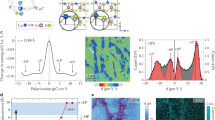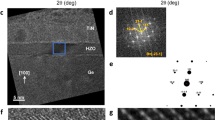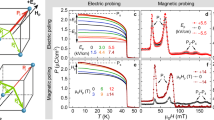Abstract
The stability of spontaneous electrical polarization in ferroelectrics is fundamental to many of their current applications, which range from the simple electric cigarette lighter to non-volatile random access memories1. Research on nanoscale ferroelectrics reveals that their behaviour is profoundly different from that in bulk ferroelectrics, which could lead to new phenomena with potential for future devices2,3,4. As ferroelectrics become thinner, maintaining a stable polarization becomes increasingly challenging. On the other hand, intentionally destabilizing this polarization can cause the effective electric permittivity of a ferroelectric to become negative5, enabling it to behave as a negative capacitance when integrated in a heterostructure. Negative capacitance has been proposed as a way of overcoming fundamental limitations on the power consumption of field-effect transistors6. However, experimental demonstrations of this phenomenon remain contentious7. The prevalent interpretations based on homogeneous polarization models are difficult to reconcile with the expected strong tendency for domain formation8,9, but the effect of domains on negative capacitance has received little attention5,10,11,12. Here we report negative capacitance in a model system of multidomain ferroelectric–dielectric superlattices across a wide range of temperatures, in both the ferroelectric and paraelectric phases. Using a phenomenological model, we show that domain-wall motion not only gives rise to negative permittivity, but can also enhance, rather than limit, its temperature range. Our first-principles-based atomistic simulations provide detailed microscopic insight into the origin of this phenomenon, identifying the dominant contribution of near-interface layers and paving the way for its future exploitation.
This is a preview of subscription content, access via your institution
Access options
Subscribe to this journal
Receive 51 print issues and online access
$199.00 per year
only $3.90 per issue
Buy this article
- Purchase on Springer Link
- Instant access to full article PDF
Prices may be subject to local taxes which are calculated during checkout



Similar content being viewed by others
References
Scott, J. F. & Paz de Araujo, C. A. Ferroelectric memories. Science 246, 1400–1405 (1989)
Naumov, I. I., Bellaiche, L. & Fu, H. Unusual phase transitions in ferroelectric nanodisks and nanorods. Nature 432, 737–740 (2004)
Garcia, V. et al. Giant tunnel electroresistance for non-destructive readout of ferroelectric states. Nature 460, 81–84 (2009)
Kim, D. J. et al. Ferroelectric tunnel memristor. Nano Lett. 12, 5697–5702 (2012)
Bratkovsky, A. M. & Levanyuk, A. P. Very large dielectric response of thin ferroelectric films with the dead layers. Phys. Rev. B 63, 132103 (2001)
Salahuddin, S. & Datta, S. Use of negative capacitance to provide voltage amplification for low power nanoscale devices. Nano Lett. 8, 405–410 (2008)
Krowne, C. M., Kirchoefer, S. W., Chang, W., Pond, J. M. & Alldredge, L. M. B. Examination of the possibility of negative capacitance using ferroelectric materials in solid state electronic devices. Nano Lett. 11, 988–992 (2011)
Fong, D. D. et al. Ferroelectricity in ultrathin perovskite films. Science 304, 1650–1653 (2004)
Catalan, G., Jiménez, D. & Gruverman, A. Ferroelectrics: Negative capacitance detected. Nat. Mater. 14, 137–139 (2015)
Bratkovsky, A. M. & Levanyuk, A. P. Depolarizing field and “real” hysteresis loops in nanometer-scale ferroelectric films. Appl. Phys. Lett. 89, 253108 (2006)
Cano, A. & Jiménez, D. Multidomain ferroelectricity as a limiting factor for voltage amplification in ferroelectric field-effect transistors. Appl. Phys. Lett. 97, 133509 (2010)
Luk’yanchuk, I., Pakhomov, A., Sené, A., Sidorkin, A. & Vinokur, V. Terahertz electrodynamics of 180° domain walls in thin ferroelectric films. Preprint at http://arxiv.org/abs/1410.3124 (2014)
Ponomareva, I., Bellaiche, L. & Resta, R. Dielectric anomalies in ferroelectric nanostructures. Phys. Rev. Lett. 99, 227601 (2007)
Stengel, M., Vanderbilt, D. & Spaldin, N. A. Enhancement of ferroelectricity at metal–oxide interfaces. Nat. Mater. 8, 392–397 (2009)
Mehta, R. R., Silverman, B. D. & Jacobs, J. T. Depolarization fields in thin ferroelectric films. J. Appl. Phys. 44, 3379–3385 (1973)
Junquera, J. & Ghosez, P. Critical thickness for ferroelectricity in perovskite ultrathin films. Nature 422, 506–509 (2003)
Khan, A. I. et al. Experimental evidence of ferroelectric negative capacitance in nanoscale heterostructures. Appl. Phys. Lett. 99, 113501 (2011)
Appleby, D. J. R. et al. Experimental observation of negative capacitance in ferroelectrics at room temperature. Nano Lett. 14, 3864–3868 (2014)
Gao, W. et al. Room-temperature negative capacitance in a ferroelectric–dielectric superlattice heterostructure. Nano Lett. 14, 5814–5819 (2014)
Khan, A. I. et al. Negative capacitance in a ferroelectric capacitor. Nat. Mater. 14, 182–186 (2015)
Luk’yanchuk, I. A., Lahoche, L. & Sené, A. Universal properties of ferroelectric domains. Phys. Rev. Lett. 102, 147601 (2009)
Kopal, A., Mokrý, P., Fousek, J. & Bahník, T. Displacements of 180° domain walls in electroded ferroelectric single crystals: the effect of surface layers on restoring force. Ferroelectrics 223, 127–134 (1999)
Dawber, M. et al. Tailoring the properties of artificially layered ferroelectric superlattices. Adv. Mater. 19, 4153–4159 (2007)
Wojdeł, J. C., Hermet, P., Ljungberg, M. P., Ghosez, P. & Íñiguez, J. First-principles model potentials for lattice-dynamical studies: general methodology and example of application to ferroic perovskite oxides. J. Phys. Condens. Matter 25, 305401 (2013)
Blatter, G., Feigel’man, M. V., Geshkenbein, V. B., Larkin, A. I. & Vinokur, V. M. Vortices in high-temperature superconductors. Rev. Mod. Phys. 66, 1125–1388 (1994)
De Guerville, F., Luk’yanchuk, I., Lahoche, L. & El Marssi, M. Modeling of ferroelectric domains in thin films and superlattices. Mater. Sci. Eng. B 120, 16–20 (2005)
Wojdeł, J. C. & Íñiguez, J. Ferroelectric transitions at ferroelectric domain walls found from first principles. Phys. Rev. Lett. 112, 247603 (2014)
Lichtensteiger, C., Fernandez-Pena, S., Weymann, C., Zubko, P. & Triscone, J.-M. Tuning of the depolarization field and nanodomain structure in ferroelectric thin films. Nano Lett. 14, 4205–4211 (2014)
Aguado-Puente, P. & Junquera, J. Ferromagneticlike closure domains in ferroelectric ultrathin films: first-principles simulations. Phys. Rev. Lett. 100, 177601 (2008)
Warusawithana, M. P. et al. A ferroelectric oxide made directly on silicon. Science 324, 367–370 (2009)
Landau, L. & Lifshits, E. On the theory of the dispersion of magnetic permeability in ferromagnetic bodies. Phys. Zeitsch. Sow. 8, 153–169 (1935)
Kittel, C. Theory of the structure of ferromagnetic domains in films and small particles. Phys. Rev. 70, 965–971 (1946)
Stephanovich, V. A., Luk’yanchuk, I. A. & Karkut, M. G. Domain-enhanced interlayer coupling in ferroelectric/paraelectric superlattices. Phys. Rev. Lett. 94, 047601 (2005)
Catalan, G., Schilling, A., Scott, J. F. & Gregg, J. M. Domains in three-dimensional ferroelectric nanostructures: theory and experiment. J. Phys. Condens. Matter 19, 132201 (2007)
Sené, A. Theory of Domains and Nonuniform Textures in Ferroelectrics. PhD thesis, Universite de Picardie (2010)
Zubko, P. et al. Electrostatic coupling and local structural distortions at interfaces in ferroelectric/paraelectric superlattices. Nano Lett. 12, 2846–2851 (2012)
Plonka, R., Dittmann, R., Pertsev, N. A., Vasco, E. & Waser, R. Impact of the top-electrode material on the permittivity of single-crystalline Ba0.7Sr0.3TiO3 thin films. Appl. Phys. Lett. 86, 202908 (2005)
Stengel, M. & Spaldin, N. A. Origin of the dielectric dead layer in nanoscale capacitors. Nature 443, 679–682 (2006)
Catalan, G., O’Neill, D., Bowman, R. M. & Gregg, J. M. Relaxor features in ferroelectric superlattices: a Maxwell–Wagner approach. Appl. Phys. Lett. 77, 3078–3080 (2000)
Ghosez, P., Cockayne, E., Waghmare, U. V. & Rabe, K. M. Lattice dynamics of BaTiO3, PbTiO3, and PbZrO3: a comparative first-principles study. Phys. Rev. B 60, 836–843 (1999)
Bousquet, E. et al. Improper ferroelectricity in perovskite oxide artificial superlattices. Nature 452, 732–736 (2008)
Lisenkov, S. & Bellaiche, L. Phase diagrams of BaTiO3/SrTiO3 superlattices from first principles. Phys. Rev. B 76, 020102 (2007)
García, A. & Vanderbilt, D. Electromechanical behavior of BaTiO3 from first principles. Appl. Phys. Lett. 72, 2981–2983 (1998)
Aguado-Puente, P. & Junquera, J. Structural and energetic properties of domains in PbTiO3/SrTiO3 superlattices from first principles. Phys. Rev. B 85, 184105 (2012)
Ponomareva, I., Bellaiche, L. & Resta, R. Relation between dielectric responses and polarization fluctuations in ferroelectric nanostructures. Phys. Rev. B 76, 235403 (2007)
Wojdeł, J. C. & Íñiguez, J. Testing simple predictors for the temperature of a structural phase transition. Phys. Rev. B 90, 014105 (2014)
Zubko, P. et al. Ferroelectric domains in PbTiO3/SrTiO3 superlattices. Ferroelectrics 433, 127–137 (2012)
Acknowledgements
We acknowledge financial support from the EPSRC (Grant No. EP/M007073/1; P.Z. and M.H.), the A. G. Leventis Foundation (M.H.); FNR Luxembourg (Grant No. FNR/P12/4853155/Kreisel; J.I.), MINECO-Spain (Grant No. MAT2013-40581-P; J.I. and J.C.W.), the Swiss National Science Foundation Division II (J.-M.T. and S.F.-P.), the European Research Council under the European Union’s Seventh Framework Programme (FP7/2007-2013)/ERC (Grant No. 319286 (Q-MAC); J.-M.T. and S.F.-P.), and the EU-FP7-ITN project NOTEDEV (Grant No. 607521; I.L.).
Author information
Authors and Affiliations
Contributions
P.Z., M.H., S.F.-P. and J.-M.T. performed and analysed the experiments. A.S. and I.L. developed the phenomenological theory. J.C.W. and J.I. developed the atomistic models and performed the simulations.
Corresponding authors
Ethics declarations
Competing interests
The authors declare no competing financial interests.
Extended data figures and tables
Extended Data Figure 1 XRD characterization of the superlattices.
a, Intensity profiles around the (002) substrate reflection for Pb0.5Sr0.5TiO3–SrTiO3 (PST-STO) superlattices. The broad peaks around 2θ = 45.5° correspond to the top and bottom SrRuO3 electrodes. Finite-size oscillations due to the 200-nm superlattice thickness are visible. b, c, XRD domain satellites for Pb0.5Sr0.5TiO3–SrTiO3 (b) and PbTiO3–SrTiO3 (PTO-STO; c) superlattices. Insets, domain periodicities obtained from fitting the Qx line profiles using a sum of two Gaussian functions for the domain satellites and a Lorentzian function for central Bragg peak. The error bars were determined from the 95% confidence bounds for the peak positions obtained from the fits. nd is the number of SrTiO3 layers in the (14, nd) (b) or (5, nd) (c) superlattices; Qx is the in-plane reciprocal-space coordinate.
Extended Data Figure 2 Local polarization distribution at low temperature.
Arrows indicate the dipole component within the  plane; we plot arrows for Pb/Sr-centred and Ti-centred dipoles. The colouring indicates the polarization P component along
plane; we plot arrows for Pb/Sr-centred and Ti-centred dipoles. The colouring indicates the polarization P component along  , revealing a low-temperature polar order at the domain walls. PTO, PbTiO3; STO, SrTiO3.
, revealing a low-temperature polar order at the domain walls. PTO, PbTiO3; STO, SrTiO3.
Extended Data Figure 3 Comparison with experiment.
Reciprocal dielectric constant 1/εf of the PbTiO3 layers as a function of temperature T, calculated from the computed total dielectric constants of (8, nd) superlattices using the same analysis as for the experimental data.
Extended Data Figure 4 Interface capacitance contributions.
a, SrRuO3–SrTiO3 interface contribution Ci to the dielectric response. b, Dielectric stiffness 1/εf of the PbTiO3 layers with (blue) and without (red) correcting for the interface capacitance. Grey (a) and blue and pink (b) shading indicates estimated uncertainties obtained from weighted-least-squares linear fits.
Extended Data Figure 5 Dielectric impedance spectroscopy of PbTiO3–SrTiO3 superlattices.
Real (C′; filled circles) and imaginary (C″; open circles) parts of the complex capacitance function C = C′ + iC″ for a (5, 8)30 PbTiO3–SrTiO3 superlattice. For temperatures below about 650 K, the data are well fitted by a single parallel R–C element in series with Rs, as shown by solid curves for the 500 K (blue) and 600 K (orange) data. At higher temperatures, Maxwell–Wagner relaxations appear as the conductivities of some layers increase faster with temperature than others. At 700 K (red), the response is qualitatively captured by a model with two parallel R–C elements in series with each other (dashed red curve), whereas for a quantitative fit three R–C elements are required (solid red curve). The inset shows the arrangement of elements in the generalized equivalent circuit used to fit the data.
Extended Data Figure 6 Temperature evolution of the tetragonality and domain satellites.
Intensity of the XRD domain satellite (filled red circles) and the film tetragonality (c/a; open blue squares) for a (5, 4)28 PbTiO3–SrTiO3 superlattice. The satellite intensity was obtained by integrating the measured intensity of the domain satellites and subtracting the minimum integrated intensity in the paraelectric phase. Vertical blue line marks the temperature at which linear fits to the low- and high-temperature data (blue lines) intersect.
Supplementary information
High temperature fluctuations of the domain structure
Local dipoles (z component) at the mid plane of the PbTiO3 layer in our (8,2) simulated superlattice. The video is constructed from snapshots of a Monte Carlo simulation at 400 K. (MP4 4861 kb)
Rights and permissions
About this article
Cite this article
Zubko, P., Wojdeł, J., Hadjimichael, M. et al. Negative capacitance in multidomain ferroelectric superlattices. Nature 534, 524–528 (2016). https://doi.org/10.1038/nature17659
Received:
Accepted:
Published:
Issue Date:
DOI: https://doi.org/10.1038/nature17659
This article is cited by
-
Validating negative differential capacitance for advanced low-power devices
Nature Electronics (2023)
-
Quantum criticality at cryogenic melting of polar bubble lattices
Nature Communications (2023)
-
Two-dimensional ferroelectrics from high throughput computational screening
npj Computational Materials (2023)
-
Polar meron-antimeron networks in strained and twisted bilayers
Nature Communications (2023)
-
Progress in percolative composites with negative permittivity for applications in electromagnetic interference shielding and capacitors
Advanced Composites and Hybrid Materials (2023)
Comments
By submitting a comment you agree to abide by our Terms and Community Guidelines. If you find something abusive or that does not comply with our terms or guidelines please flag it as inappropriate.



